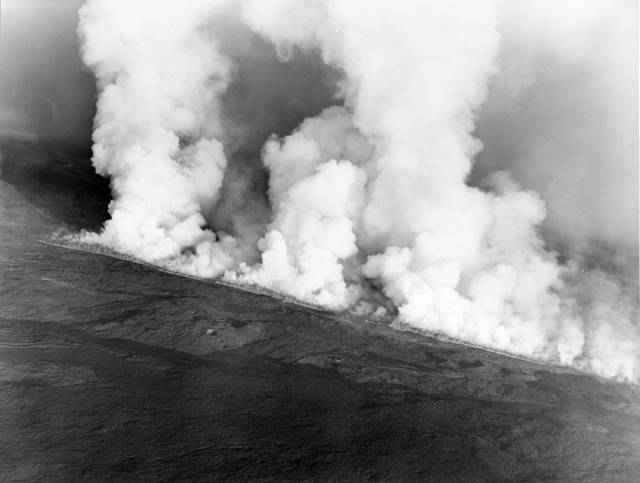On June 13, 1950, Honolulu was suddenly blanketed by the thickest haze seen since recordkeeping began there in 1906. Interestingly, the haze was first noticed four days earlier at Johnston Island, 800 miles southwest of Oahu, and then on June
On June 13, 1950, Honolulu was suddenly blanketed by the thickest haze seen since recordkeeping began there in 1906. Interestingly, the haze was first noticed four days earlier at Johnston Island, 800 miles southwest of Oahu, and then on June 12 at Wake Island, 1,500 miles west-southwest. The total area covered by the dense haze layer was estimated to be 1.2 million square miles.
The Weather Bureau in Honolulu, led by an up-and-coming new meteorologist named Robert H. Simpson, described the phenomenon as a “dry haze … due to a concentration of salt particles …and other impurities such as smoke.”
The bureau surmised the haze was trapped beneath a stable layer of air we know today as the inversion layer, which prevented vertical movement of the haze. So, although the Weather Bureau was able to roughly characterize the nature of the haze by where it was found, its cause was still a mystery.
This was the era of atmospheric nuclear testing in the Marshall Islands, so an atomic blast was the first suspected cause. But that was quickly ruled out after Geiger counters, operated by the Hawaii Sugar Planters’ association, detected no radiation.
Simpson and his colleagues at the Weather Bureau had three remaining hypotheses for what caused the thick haze:
The first was that there had been a cataclysmic eruption (like Krakatoa in 1883 or Katmai in 1912) someplace on Earth at some distance, probably to the southwest. However, none was known in recent times.
A second hypothesis was that a giant dust storm somewhere in the world had ejected fine dust particles high into the atmosphere and they were carried to Hawaii by winds aloft. Although dust from storms in the Gobi Desert of northern China and Mongolia has been detected in Hawaii, no such storm was happening then.
The third hypothesis was that the haze was indirectly caused by the Mauna Loa eruption going on at the time. According to mainland geologists, Mauna Loa could not have directly caused the haze because it was a “quiet” type of volcano, not explosive, like Krakatoa in 1883. They acknowledged that the Mauna Loa eruption, specifically its ocean entries, probably contributed to the haze but was not a main component because the haze appeared to move toward, rather than from, Mauna Loa.
More testing was done on the particles collected from the haze. Hawaii Board of Health analysis showed “500 to 600 times the normal amount of suspended particles in Honolulu’s air.” Twenty-two percent of the particles were salt and the rest were unidentified dark, slightly acidic solids. Pineapple Research Institute scientists found more sulfate than salt in the soluble particles (prompting the term “smalt” for the haze — combining the words “smog” and “salt”), suggesting a volcanic source.
With Mauna Loa looking more likely as the source, Simpson suggested that high altitude winds might have carried emissions westward to Wake (and Johnston?) Islands, where lower level winds blew the haze back to Hawaii. A colleague, Captain Charles K. Stidd, commanding officer of the 199th weather station, Hawaii Air National Guard, suggested that, because the inversion layer rose above the elevation of Mauna Loa’s vents during the time that haze covered the Hawaiian Islands, it may have allowed Mauna Loa emissions to remain within the lower atmosphere around the islands. Capt. Stidd called the haze “vog.” Once the inversion layer dropped below Mauna Loa’s erupting vents, the haze was again confined above the inversion layer. Trade winds then cleared it out of the Hawaiian Islands and minds.
Simpson, the weatherman searching for the mystery haze’s origin, later founded what is now the Mauna Loa Observatory (a National Oceanic and Atmospheric Administration research facility), among his other career contributions. Since the time of Simpson, Stidd, and the 1950 Mauna Loa eruption, our understanding of vog and its effects on humans, agriculture, and the natural environment has increased as well.
Hawaiian Volcano Observatory staff recently updated the U.S. Geological Survey Fact Sheet on vog. This four-page document, “Volcanic Air Pollution in Hawaii,” can be found online at https://pubs.er.usgs.gov/publication/fs20173017.
Volcano Watch is a weekly article and activity update written by U.S. Geological Survey Hawaiian Volcano Observatory scientists.
Volcano Activity Updates
This past week, Kilauea Volcano’s summit lava lake level fluctuated in concert with summit inflation and deflation, ranging 43-72 feet below the vent rim. On the East Rift Zone, the 61g flow was still active, with lava entering the ocean near Kamokuna and surface breakouts downslope of Pu‘u ‘O‘o. These flows do not pose an immediate threat to nearby communities.
Mauna Loa is not erupting. During the past week, small-magnitude earthquakes were recorded primarily beneath the upper southwest rift zone of the volcano, at depths up to 3 miles, and the east flank at depths of 8 miles. A magnitude 3.7 earthquake occurred in the upper Southwest Rift Zone on April 26. GPS measurements continue to show deformation related to inflation of a magma reservoir beneath the summit and upper Southwest Rift Zone. No significant changes in volcanic gas emissions were measured.
No earthquakes were reported felt in Hawaii during the past week.
Visit https://hvo.wr.usgs.gov for past Volcano Watch articles, Kilauea daily eruption updates, Mauna Loa weekly updates, volcano photos, recent earthquakes info, and more; call for summary updates at (808)967-8862 (Kilauea) or (808)967-8866 (Mauna Loa); email questions to askHVO@usgs.gov.



